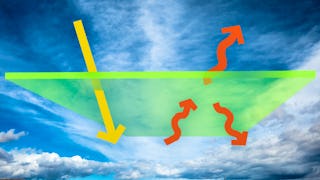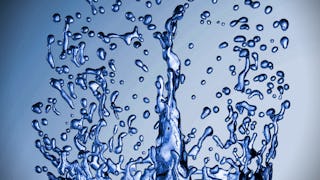This class provides a series of Python programming exercises intended to explore the use of numerical modeling in the Earth system and climate sciences. The scientific background for these models is presented in a companion class, Global Warming I: The Science and Modeling of Climate Change. This class assumes that you are new to Python programming (and this is indeed a great way to learn Python!), but that you will be able to pick up an elementary knowledge of Python syntax from another class or from on-line tutorials.


Global Warming II: Create Your Own Models in Python

Instructeur : David Archer
16 353 déjà inscrits
Inclus avec 
(54 avis)
(54 avis)
Compétences que vous acquerrez
- Catégorie : Programming Principles
Détails à connaître

Ajouter à votre profil LinkedIn
6 devoirs
Découvrez comment les employés des entreprises prestigieuses maîtrisent des compétences recherchées


Obtenez un certificat professionnel
Ajoutez cette qualification à votre profil LinkedIn ou à votre CV
Partagez-le sur les réseaux sociaux et dans votre évaluation de performance

Il y a 5 modules dans ce cours
This class is intended to complement a Coursera class called Global Warming I: The Science and Modeling of Climate Change, which presents much of the background to the material here. In this class you'll be using spreadsheets (maybe) and Python (definitely) to do some simple numerical calculations on topics in Earth System Science. The model you'll be working on this week is based on material from Unit 3 of that class, called First Climate Model.
Inclus
2 vidéos6 lectures1 devoir1 devoir de programmation1 évaluation par les pairs
The ideas behind this model were explained in Unit 7, Feedbacks, in Part I of this class. First we get to generate simple linear "parameterization" functions of planetary albedo and the latitude to which ice forms (colder = lower latitude ice). Second, for any given value of the solar constant, L, we'll use iteration to find consistent values of albedo and T, to show the effect of the ice albedo feedback on Earth's temperature, running away to fall into the dreaded "snowball Earth".
Inclus
1 vidéo3 lectures1 devoir1 devoir de programmation1 évaluation par les pairs
Ice flows like extra-thick molasses, downhill. The shape of the ice sheet (altitude versus distance across) is determined by the relationship between ice surface slope and the flow rate of the ice.
Inclus
1 vidéo3 lectures1 devoir1 devoir de programmation1 évaluation par les pairs
Planetary rotation and fluid flow were explained in Part I of this class, Unit 6, on Weather and Climate.
Inclus
1 vidéo1 lecture2 devoirs3 devoirs de programmation1 évaluation par les pairs
Background for this model was presented in Part I of this class, Unit 9, The Perturbed Carbon Cycle.
Inclus
1 vidéo4 lectures1 devoir1 devoir de programmation1 évaluation par les pairs
Instructeur

Offert par
Recommandé si vous êtes intéressé(e) par Environmental Science and Sustainability


The University of Chicago


University of Colorado Boulder


Edureka


University of Geneva
Pour quelles raisons les étudiants sur Coursera nous choisissent-ils pour leur carrière ?




Avis des étudiants
54 avis
- 5 stars
55,55 %
- 4 stars
20,37 %
- 3 stars
12,96 %
- 2 stars
3,70 %
- 1 star
7,40 %
Affichage de 3 sur 54
Révisé le 18 juin 2016
Really good course. Short, content-filled lectures and practical application!
Révisé le 29 janv. 2021
Great course, really interesting! The difficulty of the course didn't follow a linear growth, as week 4 was much more difficult than the others.
Révisé le 15 févr. 2017
I would love some more excercises, more modeling concepts. A great experience after all!

Ouvrez de nouvelles portes avec Coursera Plus
Accès illimité à 10,000+ cours de niveau international, projets pratiques et programmes de certification prêts à l'emploi - tous inclus dans votre abonnement.
Faites progresser votre carrière avec un diplôme en ligne
Obtenez un diplôme auprès d’universités de renommée mondiale - 100 % en ligne
Rejoignez plus de 3 400 entreprises mondiales qui ont choisi Coursera pour les affaires
Améliorez les compétences de vos employés pour exceller dans l’économie numérique
Foire Aux Questions
Access to lectures and assignments depends on your type of enrollment. If you take a course in audit mode, you will be able to see most course materials for free. To access graded assignments and to earn a Certificate, you will need to purchase the Certificate experience, during or after your audit. If you don't see the audit option:
The course may not offer an audit option. You can try a Free Trial instead, or apply for Financial Aid.
The course may offer 'Full Course, No Certificate' instead. This option lets you see all course materials, submit required assessments, and get a final grade. This also means that you will not be able to purchase a Certificate experience.
When you purchase a Certificate you get access to all course materials, including graded assignments. Upon completing the course, your electronic Certificate will be added to your Accomplishments page - from there, you can print your Certificate or add it to your LinkedIn profile. If you only want to read and view the course content, you can audit the course for free.
You will be eligible for a full refund until two weeks after your payment date, or (for courses that have just launched) until two weeks after the first session of the course begins, whichever is later. You cannot receive a refund once you’ve earned a Course Certificate, even if you complete the course within the two-week refund period. See our full refund policy.
Plus de questions
Aide financière disponible,